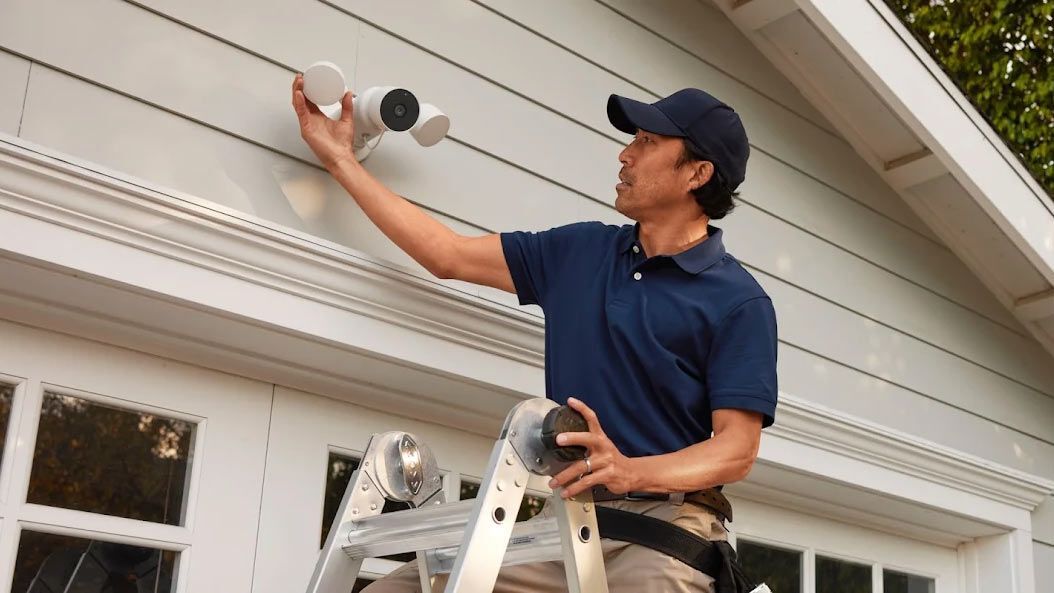If you have to run power to it, you might as well run some data as well. Never really the best idea to have mission critical equipment at the mercy of a congested wifi network.
Save some trouble and go with POE. A little more expense to setup, but you only have to run one wire and everything is permanently hardwired.
I’m hard pushing my family and friends to replace/install POE switches currently. Its a minor cost upgrade that will make my life so much easier
Heck yeah. In addition to POE, I’ve got a power line adapter setup to the NVR so that the cams are all hardwired to the modem/router combo. It’s fast enough for remote viewing in HD.
What system do you have and how many cameras. We are moving north and I wanted to get a POE system and am looking for recommendations. Obviously Costco has some options but they are going to be pretty basic and have iffy reviews.
These are 3 outdoor cameras I helped setup for my bestie. I’m pretty sure she went with a no name brand. The UI is the same UI you see in other basic NVR’s out there. It was likely an Amazon or Costco purchase. This was a few years ago, the details are a bit hazy. I helped setup the software on a non-PoE system and it looked exactly the same. I’m sorry I couldn’t be of much help…
A lot of the new systems can use battery powered cameras that are motion activated - they can last for a month+ on battery because they only turn fully on when they detect motion.
You’re right though - if it’s mission critical don’t rely on wireless.
Some of them even have solar panels as well. It’s very useful if you want to DYI installation without having to run cables all over the place (data and/or power).
This Wi-Fi jamming stuff does seem like a huge issue. I was actually considering wireless down the line, but maybe a system with proper wired connections would be better.
Power over Ethernet (PoE) requires one wire for both data and power. You also need a PoE network switch, or a “PoE injector” which is basically a power brick that adds power to the network cord.
There are also poe adapters that allow you to power a non poe device. Can be useful in many situations.
Yeah, that would definitely be the way to go. You still have to run the cables all over the place, whether it’s one or two. I totally get why people go with wireless.
Trash passive IR motion detection.
Have wireless setup, works really well. If they want it that bad they can have it while I’m gone or risk their life while I’m there.
If you don’t care about your stuff, why would your risk your life to risk their lives? Lol
If it were me, I wouldn’t be as worried if I wasn’t there to lose stuff. If I was there I would be concerned with violence against me or my family. Not concerned with stuff but very concerned with safety.
That’s fair, but the other comment made it sound like they’d want to confront/attack the intruder
Literally the wet dream of every gun owner.
Entering my house without permission while I’m there is a threat.
Yeah, if someone is nutty enough to come inside, they’re getting shot. I don’t live in a fortress, but you have to make the effort, and anyone making that effort probably doesn’t have my family’s well-being in mind.
I also had a bear wander in my giant dog door, so there’s that as well.
We’ve had armed break ins near my house. One house they tried to break in ended up unloading on the group. Got away but haven’t heard of any robberies in the area for the past 6 months.
Siri, turn off all lights and play one winged angel
The version from Advent Children, by preference.
there are some things about america that i will just never understand
Electricity is already wired throughout, you just need to get to the closest plug. You have to run ethernet the whole length and it has length limitations. It’s not trivial.
I mean ethernet has a range of 100 meters in one run (including with POE), which is probably going to be longer than the WiFi range assuming the WiFi access point is at the switch and it’s a relatively straight run. If you need more range a small 4 port POE switch is hardly likely to break the bank if you have a property big enough to need over 100 meters of ethernet in one run.
Isn’t there ethernet over power or something like that?
There is indeed ethernet over power and I have been using it for almost 2 decades to connect a desktop PC in a room to the router in a different room in the various places I lived in over the years.
It used to be only 20Mb/s way back in the beginning but nowadays (last I checked) 500Mb/s was common.
I keep expecting this stuff to just come integrated in devices that are supposed to be wired to mains and also need network access to move around lots of data but I have yet to found such option built-in on auch devices: ethernet over power support usually comes in as a just a wall socket plug that also has an ethernet socket.
That said, it works better if all plugs are on the same mains network with now breaker boxes in between since the high frequency signals needed to transport data at high speeds don’t travel through inductors that well. I’m not quite sure how big houses in the US are wired, but this might be a problem if the device is trying to send lots if data across and the device and the router are in different mains subnetworks.
deleted by creator
If you’re in an apartment, is this like putting everything on the same switch? Could you snoop your neighbors traffic? How is that secured?
Those things need to be paired to be able to see each other’s data stream so I assume it’s encrypted.
Also there are almost certainly TWO big breaker boxes (one for each appartment) plus meters - all of which with coils, which filter out high frequency signals - between your network and your neighbours’, so your bandwidth is not going to be suffering from neighbours that are using a similar system, unlike with anything radio-based like Wi-Fi.
I actually suspect this is even better suited for appartments than for standalone dwellings when your objective is bandwidth, because the signal will basically stop at the breaker box so you don’t really interfere with each other whilst with Wi-Fi what stops interference is distance (and big thick walls or large metal surfaces) so appartment buildings are pretty nightmarish for it because everybody is so near everybody else.
My own personal experience with this is all in appartment buildings and I actually first tried it back in the day when everybody and their dog started getting Wi-Fi and routers had become smart enough to automatically search for a less constrained Wi-Fi channel on setup (before that they all just used a default channel, so for a few years manually reconfiguring my router to use a different channel other than default would put me in a clean area of the spectrum few neighbours used) because Wi-Fi bandwidth by then had become was so bad whenliving in an appartment because of ther being so many people with their own networks in such close proximity.
Doorbell cameras are tricky there. They’re designed for the lowest common denominator and expect you to use the existing wiring for power, but nothing else. No PoE connections for that.
My other cameras are PoE, though. Madness not to.
I use a reolink poe doorbell camera. It’s a bitch to replace your doorbell wire with Ethernet but it’s really worth it for the zero lag and camera still working during a power outage because my server is on a UPS. plus the wires can be used for a traditional doorbell if I sell the house, I just pick a pair and power them.
Ring has a PoE doorbell. Expensive though
Just because they are popular and cheaper doesn’t mean it’s a good idea.
See also: Bathtub inserts, countertop veneers, cheap EIFS stucco, overlay roofing, etc.
Solar/battery cameras.
It’s been echod several times in this thread already but:
Wireless and security are oil and water. They do not mix. This goes byond wifi. If your security system has wireless sensors (door, window, motion) - you aren’t secure. Please do not buy smart locks.
Wireless cameras are not security - they are a convenience. A convenience for checking on the kids in the back or seeing if that package got delivered.
If it’s not wired and powered it is at best a scarecrow and at worse an indicator that you have money and you feel secure.
Smart locks are fine. Your door isn’t particularly secure with a regular lock. If they want in enough to bring tech, they are coming in anyway.
I don’t disagree with that. If someone wants in they’re coming in. 100% agreed. The trick is making your self less of an easy target and cutting down on easy ins.
My statement was pretty generic as there is a lot of nuance to locks and security. My concern lies mostly with the fact that you rarely have a suitable blending of the two technologies. Either a lock company buying a kit or an electronics company buying bulk locks. Or a company that does neither and is looking for another thing to peddle on Amazon.
Some of these locks have very poorly positioned relays. You can unlock them with a magnet. Others can be actuated using a simple emf generator. Ones with passcodes can be read with consumer grade ir sensors or determined by wear and fingerprints.
Reducing attack vectors is always preferred. But it is absolutely up to the end user where their balance between convenience and security lies.
A good deadbolt and key while average is still superior as it is only 3ish attack vectors: pick or impression, destruction of door/lock, and the trusty rock:
Most doors have poorly placed windows with standard glass in or next to them.
They busted the door off the hinges when they broke into my house once. One of your doors is an open in door… those are kick in doors as the guy was telling me when he replaced mine.
This is one thing I don’t understand- I was looking at getting a door replaced and they looked at me like I had two heads when I asked about reinforcement to make it difficult to kick in.
I’ve read the weak point is generally the jamb and of course it’s only thin wood. Steel reinforcement behind the jamb could make a huge difference, so why isn’t it common?
I’m not paranoid enough to do this with existing doors and of course don’t want the ugliness of a visible lock plate, but when I’m replacing a door, I want the option of one that is more difficult to kick in, rather than just a cheap cookie cutter install
Because the average consumer is an idiot and does not think about the various technicalities associated with their purchases.
we went with a fiberglass type that was suppose to have have bounce to it, so more force would return then be absorbed. It also had to open outwards and that made it weird for a long time.
deleted by creator
That’s the standard: cheap and easy. Every lock I’ve bought since I’ve owned a house has had this. Done.
But not enough. One of my doors was clearly kicked in for a previous owner, yet I saw long screws into the frame. That doesn’t guarantee they were there at the time but they might have.
Regardless, the jamb is thin wood not really supported by anything. Screwing the strike plate into the framing helps, but that doesn’t keep the jamb from buckling and breaking until the door is no longer held by the strike plate. Reinforcing that jamb can make a huge difference against a standard burglar.
How about a 60” steel reinforcement?
Or here are some good ideas - residential doors already have some of these covered by opening inward, rather than out
Over here (UK) it’s pretty common for doors to be multi point locking, so you shut the door and lift the handle which engages a series of extra bolts between the door and frame, most commonly one at the handle then one at the top and bottom of the frame. The early PVC doors that introduced multi point locking did have an issue (poor construction) where people could kick out the middle panel leaving the frame in place, newer ones have improved it, and there are more expensive doors which are made of different materials, but will almost always feature multi point locking.
That’s a great idea too.
I’ve seen that in moves but never in real life, nor have I seen hardware for it at any home center I’ve been to
Our exterior doors are usually steel or more expensive are a heavy fiberglass, antique are wood, but always heavy duty. I guess I’ve seen flimsy doors in cottages or apartment conversions but I can’t imagine that passing building code for any permitted construction
deleted by creator
Smart locks are worse. They have all the insecurity of a regular lock, plus more methods of insecurity, plus more failure modes that will shut you out of your house.
Ehh, they sell models with no keyhole now. At least youre trading risks at that point.
Or in my case, the entire front door is made of glass…
Here in belgium our doors sacrifice everything in the name of marginally more security: fire safety, failure modes & maintainability, convenience, and protection from user error.
-
Each modern door has 2+ deadbolts + hooks, many times a strike plate that is a bit bit more crowbar resistant, etc… but the mechanism is all tied to the handle so you can’t lock the door if the handle sticks because of lack of maintenance or -10C weather. This also is about 1500€ to replace if you break it trying to lock your door when it is sticking.
-
Many doors have no front handle, so if you leave your keys inside (even if you are just running to get the mail), you are locked out. If someone leaves the keys on the inside of the eurocylinder, you can’t unlock it from the outside unless you bump the keys out which isn’t too easy for someone who only has a key.
-
Finally, almost no doors nowadays have a deadbolt dials on the inside, so you have to lock it from inside with keys. This means that both someone who steals a key can lock you inside (see point 2) and also it is a huge fire hazard because you can’t open the door from the inside without a key. You either have to hope that you aren’t too blind and dazed from smoke during a fire to find the keys, get them in the lock, and get outside, or leave the keys in the lock and completely negate the security benefit of having no deadbolt dial + the added inconvenience of another person living there unable to get inside if they come home later.
Then, on my door and many other modern doors here the security that they sacrifice so much functionality for is negated in any case because there is a 60x180cm double glass pane that they can simply break through. It is literally the worst system I have ever come across lol
-
Technically, some criminals will see it and pass on the house assuming there is an alarm system. The failure modes is a good point though.
Most smartlocks have a bypass lock for power cuts etc. that is shockingly easy to pick.
Regardless of how easy they are you pick, every house has giant holes cut in the walls with nothing but a couple panes of glass separating the inside from the outside.
Do you mean windows?
Time to put linux in my walls
Those are just dumb.
I have a smart lock that is just on the inside, there is nothing outside to indicate a smart lock.
Yes, someone could hack into my home assistant and open the door, but with that level of skill they would be earning 6 figures in a red team somewhere, not stealing my raspberry Pis and IKEA furniture…
Most regular door locks are easy to pick.
isn’t that the equivalent to having an unlock button on your front door.
It’s not just that your lock won’t work if there’s no power but most of these seem to be battery powered, so you face this issue every few months. In case of a power outage or dead battery, is it better to be locked out or better to prioritize people’s safety
While “fail safe” sounds bad that your door is now unlocked, remember that it’s only on a power outage or dead battery, depending on configuration. It’s not like a thief can really plan for it, especially if it means planning for you to have a dead battery. It’s up to you how long it stays like this before you replace the battery, and it really should be a very small percentage of time. It’s not as bad as it first seems
there was show hosted by reformed burglars. One of the things they look for was expensive things in the front yards, being in planned community with few roads going into or out of. To get past home camera they wore hats and kept looking down, and just showed up in a lawn care or pool cleaning van.
And if you look at police report and court cases, do these camera make catching thieves more likely? No they don’t
I don’t love somewhere where people dress up as Scooby Doo villains to break into houses, I live in a place where people go house to house at 1 am and try door handles on cars and garages. A motion light and a camera does more to stop those people than anything else.
If someone wants to stage an organized heist, then yea, my camera isn’t doing shit, but neither are my door locks, or a bolted down safe. At that point it is just an insurance game.
Was it It Takes A Thief? I remember that show; it was actually pretty interesting
Yes that was it
if they have a wifi jammer they have spray paint
Low tech solution sure - you need to walk up to the camera and would need the location of any cameras that would potentially catch you as you scooter around tagging the cameras. Advantage is you are 100 sure the cam can’t see you.
Deauth attacks work very well and don’t require you to nuke all of the wireless space.
There’s a variety of different attacks. Admittedly destroying the camera is more or less a sure thing hah.
Here in belgium it is illegal to have hidden security cameras. You also have to put up a visible sign if you have them.
Location of the cameras here is easy lol
There is an advantage to advertising their existence: the sign itself may act as a deterrent and may motivate a thief to pick a softer target.
This of course is assuming you don’t need a sign for each camera with an arrow pointing to it… at that point perhaps just a big dog would be a better choice hah.
Many cameras record to a SD card, deauth won’t do much.
Sure there may be a hard copy but that will only have value after the crime is committed. Deauth / jamming will prevent the more meaningful things like proximity alerts and notifications from informing the user (or security system) which could lead to intervention.
I’ve always viewed camera storage as a fallback in the event something fails. Don’t get me wrong I think redundancy is great and it’s a fine feature. It has value - just less so in this particular case.
You could set up an alert for “hey, all my security cameras just misteriously disconnected”…
Not advocating for wireless security solutions, just saying it’s not so hopeless.
That would definitely be a good approach if you were stuck with the wireless option. Im sure some software may address those disconnections in just the way you describe.
My responses have been looking at the technology broadly - in the way I might if someone asked me for my opinion prior to investing in gear. People frequently overestimate the effort required to achieve a bypass of a security device. So my goal was to provide some core knowledge.
I do like the suggestion though- it may help somone improve their own existing setup 👍
That is a true statement. You can’t have both securtiy and wireless (convenience).
Every wirelessly transmitted signal, whether it is your network signal or bluetooth, can be intercepted from afar. It is even possible to encrypt the accoustic signal emitted from a needle printer and determine what has been printed because every letter/word emits a specific sound pattern. Sound travels wirelessly. This link from 2009 refers to that. Unfortenately it is written in German and I didn’t find anything in English, but you could translate it.
Edit: typos 2 nd Edit: Addition: Needle printers are still in use - at least in Germany - for printing prescriptions at doctor’s offices, among other things. The paper used for that provides a (physical) carbon copy.
Sorry for being that guy but if possible you should always refrain from using Wifi for applications in production, safety and security. Too many known and unknown vectors to its reliability.
But yea, I get it. Most people don’t know the details and on the overall market most affordable devices and services for security systems are some semi-“smart” products which are simple to set up. The extra work and cost that come with professional equipment aren’t really appreciated, eapecially by those who don’t know any better.
This is exactly why the old fashioned Analog installations cost more to begin with: They’re very secure and more difficult to disable.
Of course, the number 1 method to avoid robbery is to simply make yourself an unappealing target: no FB/Instagram stories, door that looks more solid than it is, padlocks, signage warning of dogs/firearms (even if you don’t have either). Keep your equipment, cars, or boats inside or covered. Etc. Even just a floodlight that detects motion at night and makes a beep beep sound can scare off most kids and crackheads. If you live in an apartment, put some broken furniture on your patio and people will think you’re poor.
It seems like Wifi Cams and the little signs/stickers they come with are exactly the opposite: “I HAVE SOMETHING TO HIDE THAT YOU WANT BUT HAVEN’T SECURED IT PROPERLY.”
DO NOT put gun signs/stickers up. It’s an ongoing joke that a Glock sticker on a truck means “free gun inside”.
I thought it was a discussion about homes. Ya’ll are putting wifi cameras in your cars?
Nah. Just glocks. I can barely see over the pile of guns now.
Imagine a wifi camera strapped to a glock, that’s a fun mental image.
With an fpv headset for aiming?
Same principle applies; if you have a sign up warning people that you’re armed, that means that there are free guns inside, as long as they wait until you’re away or asleep.
It’s like, don’t put the empty box for the $5000 television set out with your trash, put it out with someone else’s trash, so that people don’t know you just bought a brand new expensive piece of electronics.
You’re right that you should try to make yourself a less appealing target for thrives, but some of your methods don’t really hold up to scrutiny. Beeping motion sensor lights and secure locks and doors are great ideas. They will absolutely deter casual thrives and addicts.
Advertising that you have guns is just advertising that you have something to steal that is valuable, easy to sell, and easy to carry.
Warning signs for dogs aren’t much better. If you don’t have a dog, that will usually become obvious to anyone close enough to read the sign. If you do have a dog, then the sign is just an invitation to have them murdered the next time you have to interact with police at home. It will also expose you to liability should any trespasser be injured by that dog. Yeah, even the person robbing you, but also children, other pets, and well meaning innocent people just doing their jobs (and not breaking the law by entering your property without permission) like meter readers, mailmen, land surveyors, emergency response, etc. When I see a dog warning sign, to me it just says that a dumb asshole abusing a dog lives here.
Broken furniture sounds clever, but that just says trashy, not poor. Actual poor people take better care of their shit. HOAs would also limit the places you could actually do this without fines in the suburbs. Broken outdoor furniture is as common as weeds in more rural areas.
WiFi Cams just mean that you can afford Internet. EVERYBODY has WiFi cameras. They are ridiculously cheap to buy and easy to install. Cameras (WiFi or not) aren’t a great deterent anyway.
I feel like the risk/return on firearms isn’t great for breaking into homes at night, but if it were in an unattended vehicle then that’s another story.
You don’t actually have to own a dog, and having signage doesn’t indicate abuse in any case.
Have dogs. Also have a firearm in the house my mother has only pointed at me, while loaded. once.
The cats would likely be the ones to save us.
You’re confusing opinion and facts. My opinion is not fact (regarding dog warning signs) and I never said it was. Your feelings also are not fact.
There is no confusion here, friend. Our opinions conflict, that is all.
That’s an interesting take, and I think I might agree with you.
Solid-looking boring lock, everything looking like it would last decades, looks like someone who sorted the security confidently.
Plastic looking wifi cameras everywhere have a “curtain twitchy granny” vibe.My mom says the neighbors can’t see her looking.
I think the most primary thing of all is that, most people don’t have the means to run Ethernet cables to places that typical cameras are installed (doorbells and garage floodlights)
It’s a catch 22 though. Ok one hand, every single person in my neighborhood has multiple cameras on their property now and even when I lived in an apartment complex, everyone had a camera at their doorbell, but they all are usually ring or some other subscription based, phone home type.
Do WiFi cameras present a new attack vector, yea for sure. Is having a WiFi camera that could be disabled better than not having a camera at all (what was the reality 5 years ago), hard to say.
Every single person in your neighbourhood has multiple cameras?! Where do you live?
While it may not be strictly true, this is not difficult to imagine. Doorbell cams are ubiquitous, alarm companies push more and more each year, spotlight cams, solar cams, and other cams are cheap and have been at time “the new hotness”.
More importantly, the widespread use of motion detection even means you can monitor and respond to events.
deleted by creator
That’s like a third of nextdoor posts.
Networked cameras used for security should have local storage to buffer when the network isn’t available, regardless of if you’re using wired or wireless.
oh, sweet, sweet ethernet. how I love you.
As long as it’s not 100mbps ethernet on unshielded cable, that’s the absolute worst for RFI.
then don’t do that ¯\_(ツ)_/¯
As long as it’s not two children with cups attached to a shoestring, that’s the absolute worst.
Sure, but still harder to do than wifi
The issue with 100mbps ethernet is than it interferes with HF and VHF radio.
It would certainly be possible for radio to interfere with ethernet, but I’ve never knocked mine out even with 100 watts.
Sure, but the topic is “rf interference of your camera feeds”
You CAN interfere with Ethernet, but it’s much harder to do, as evidenced by your 100 watts
It drives me up a fucking wall that WiFi is the de-facto local device communication protocol. There are so many reasons not to use it.
Most home automation stuff seems to use Zigbee. Doesn’t have a lot of bandwidth though, so not useful for video.
And frankly, even if you have a video, the police around here won’t do shit with it unless someone has been killed.
That’s because you aren’t one of the owner class. The legally supported armed thugs don’t protect the citizenry. They protect the owners private and personal property. Your personal property isn’t worth protecting in their eyes.
I personally have many zigbee devices that I operate happily, but most entry devices by big names (e.g. Google, Amazon, Wyze) and smart-home appliances (think garage door openers, light/fan fixtures, laundry machines, ect.) end up being WiFi. Even if you’re a self-sufficient homelabber who buys all zigbee and self-hosted devices, it’s hard not to end up with a bunch of WiFi devices anyway.
And if you have a spouse who is less knowledgeable, it can be really hard to explain or justify the higher expense for something like a security camera, or dissuade them from buying a smart fan they really like because it uses an external WiFi connection for its smart features.
Zwave is great too, but still no video. Wired is the answer.
Wifi jamming is an easy thing to do, as the whole 2.4GHz band works on the assumption that everyone is nice to each other. One non-cooperative device, and everything in that band goes down: Wifi, BT, Garage door openers, Car key fobs…
Vehicle fobs are usually not in the 2.4Ghz range, they’re usually in the 300-500mhz range.
But yes, there’s a lot of assumptions and usually it’s right, but it can be wrong also.
Also, fun fact, microwave ovens use very high power 2.45Ghz. so they can do this by simply rigging a microwave to turn on when the door is open, then pointing it at your house at a safe distance, like across the street.
Most companies that make outdoor stuff generally avoid 5Ghz because it’s a regulatory nightmare. Some countries allow it, others only allow certain frequencies, others only allow certain frequencies up to a certain power level, others basically don’t allow it at all. So all your fancy door bell/cameras/whatever that you connect outside your home are all going to be limited to 2.4 GHz with is basically universally available internationally (it’s an ISM band, while the wifi 5ghz is a UNII band)… So yeah, good luck everybody!
Also wired cameras and such exist, they’re a pain to install, but they work well, and the market for other outdoor network connected things is extremely limited… Things like doorbells.
I hate putting static objects on wifi, even something like my TV, I want it wired simply because it never moves and there’s no reason to use it wirelessly. I can run a wire to it once and even if I upgrade the TV, the wire still works. To explain this a little more, I’m an IT administrator and I have a specialty in wireless networking. As tersely as I can: more stuff on the WiFi makes it slow, so if something can be wired, it should be wired. Obviously there are things that are not well suited to it, like cellphones and laptops, but pretty much everything else should be wired. TVs, set top boxes, desktop computers… Basically anything that can be wired, that doesn’t regularly move around… Wired. This extends to cameras, doorbells, gdo’s…
This frees up wireless bandwidth for devices that are obligated to use it, like your phone and tablet.
I’ve seen a lot of network issues resolved by simply plugging in everything that’s practical to plug in, even if the device having the issue wasn’t one of the things plugged in.
Yeah, i always try to connect as much as I can to ethernet cables. The issue being that it’s sometimes a pain to install the cables, especially if you’re renting and can’t really pass wires through walls
My solution when I lived in an apartment was to buy cup hooks, and white ethernet cable (either riser or plenum), as well as some ethernet wall boxes, and keystones for them. For a bit of flair, I also picked up some white hook&loop (aka velcro).
I added a few lengths of conduit/raceway for vertical runs and what I did was use the cup hooks to create a wiring tray for ethernet cables along the ceiling lines on the wall… Maybe 2 inches from the top, every 18 inches or so, I’d put a cup hook. Then, when they were placed, I ran the raceway up the walls near my network stuff, and used all of that to wire ethernet around the place. Cup hooks are self tapping, you generally don’t need any tools for it. I “pre-tapped” the holes with a small nail, just driving it in less than half an inch, then pull it right out… just to give the cup hook somewhere to bite into and set my positioning for it. The larger cup hooks can carry 4-5 ethernet, and I used the velcro to keep everything together and tidy.
On the ends, I terminated the cables to keystones, mounted them in their wall box and stuck it to the wall with 3M command strips, for easy removal later.
For me, the cables went along the base of a wall in one bedroom which we used as a computer room/office, over to the door, around the door hinge at the bottom, up the wall using conduit/raceway, along the ceiling of the hallway, over to the living room where I had two wall-mount dual ethernet boxes for four cables/connectors. I then used standard ethernet cable to run to my TV, a wireless access point, an htpc, etc.
The only other stuff in the living room was phones and other appropriately wireless equipment, the rest of the wired stuff was in the office. The TV we had in the bedroom had a cable that went through the wall to the office. I found that a telephone wiring box on the walls between the rooms was open on both sides, so I just popped the faceplates off and ran the cables.
I know my situation is unique and yours will be different. I’m hoping I can give you some ideas on how to tackle the problem without initiating aggro from either the spouse, family, or landlord.
Holy shit there’s a lot to unpack here, thank you so much for the suggestions!
Honestly in my case the issue is really that I don’t want it to be in pain to restore the flat when I leave it, and it’s rather small, I just need to pass a cable along the hallway into my office, and somehow pass the door which really does not have a lot of space around it (not enough for a standard ethernet cable, so I’m thinking about flat ethernet cables, which could work here)
But I haven’t really had time to think about it yet
Most of the time there’s a gap under most internal doors to allow for airflow between spaces. Most rooms also have ventilation and return air, but often a gap under the doors as well.
It’s normally not very much, but enough for an ethernet cable. The trick is to get it to sit neatly across the area so it doesn’t impede the swing of the door.
I like to use small nails or screws in the frame of the door to hold it against the flooring.
The hardest part for me to remove when departing my previous rental was pulling down the conduit. I didn’t use the 3M command strips for it, since it came with mounting tape pre-applied. I pulled off some of the layers of paint on the wall when it came down. It was not a big deal to the superintendent since they repaint regardless. The cup hooks took the longest since you have to untwist each from the wall by hand. They’re not fully enclosed, so pulling the cable out was simply a matter of pushing it up and out of the hook.
When done correctly, it should only take about 20 minutes to pull apart and leave little more than paint damage behind.
If that’s not appealing, and you have cable TV or some other kind of coaxial lines run between rooms, there’s MoCA as an option. It can coexist with most TV signals, and something to consider if you’re in a situation where you have the wiring needed. If only phone lines exist, it’s entirely possible to buy and use ethernet extenders that use DSL technology to relay the data. They’re not as fast as MoCA, and they may not even have as much bandwidth as wireless, depending on the conditions, but they will be far more consistent and reliable than wireless.
There is the option of powerline adapters as well, however, I would only recommend them if you have enough knowledge of the power lines in your home to determine that the plugs that the powerline adapters will be placed into are on the same circuit. If they’re not, then the situation can become very complex, or downright guesswork to try to get working. It becomes a huge risk for anyone who isn’t an electrician with enough knowledge to determine if the lines will intersect in a productive way. Here in North America where I am, we use split phase power, so if powerline adapters are used here and they end up on different hot lines, the signal essentially has to travel through either the transformer that’s delivering the power, or the neutral lines which may be afflicted with all sorts of interference from the ground being bonded to it. So if you’re not an electrician, I would say only to use powerline if the plugs you intend to put them on are on the same circuit. If not, you’re going to have significant risk for the system not working well, reliably, or possibly even have it not working at all.
I’m certain there are other options I haven’t really gotten into, but there’s plenty out there to use and try. Ethernet or fiber is generally ideal. If you can’t use that, then MoCA, and to a lesser extent DSL. If that’s not an option for whatever reason and you are in favorable conditions, maybe powerline. Beyond that, you’re stuck with wireless. Ethernet/fiber can run upwards of 100Gbps (SMF) to 10Gbps (MMF/Cat6), or mgig at 5Gbps or 2.5Gbps, and of course 1Gbps. MoCA can do an excess of 1Gbps last I checked, but lacks full duplex operation like most ethernet standards. DSL can be as fast as 250+Mbps with the right equipment, but often trends around 50-150Mbps in the simple point to point configurations you’ll find with non-ISP grade solutions. Powerline wildly fluctuates depending on conditions, but can achieve 1Gbps in ideal situations. Wireless, which by its very nature, is half duplex, is by far the most variant, if you’re the only person using it in the local area, it can be fantastic, however, such an ideal is extraordinarily rare, it interferes with everything from wireless console controllers, microwave ovens, neighbors and just about everything else made for consumers with a wireless connection. Often, it’s the most variant of the bunch and frequently has the longest ping times and jitter.
Simply put, wireless is a bad technology. Not because it was/is done poorly, but because it works so well that everyone puts everything onto it and that makes it terrible. There’s only so much wireless frequency range given out for unlicensed public use and when everyone has their own wifi, we all end up stepping on eachothers toes.
My motto is, and has been for a while: wire when you can, wireless when you have to. If everyone did that, we would be much better off.
I always find it a bit amusing when I see “shut down due to radar activity” in my 5GHz logs.
Aah yes, that’s UNII-2 in action. You can’t have a radio in the UNII-2 band without some measure of radar detection and avoidance. It’s a regulatory standard. Most will simply hop to another frequency and inform connected stations of the move, but shutting down when radar is detected, is valid.
It may be worthwhile to aggregate such reports and see if it’s the same few channels each time, then simply exclude those channels from being selected by the system. It could increase the reliability of the connection to the clients and reduce any calls about the wifi going out or kicking people off of it.
gdo’s? = God Damned Operators?
Garage door opener
My man.
Internet-of-Thieves devices.
Use POE Ethernet. Problem solved.
Any recommendations for PoE cameras?
I use hikvision and the quality is great in low light. I haven’t connected them to the internet since I use Frigate and Home Assistant to monitor the feeds.
I put mine on an unconnected network attached to a connected desktop. Videos are written and uploaded to the cloud when motion is detected. ISpy is a good open source video system even if it is written in C#.
I’ve been happy with Hikvision recording to my Qnap NAS. I’ve heard some bad ethical things about their company, but the cam works well.
UniFi Protect is outstanding. You need to buy one of their NVRs or cloud gateways to use it, but it’s incredible & wouldn’t want another system for our house/family business
Didn’t they accidentally send supposedly private video to the wrong users recently?
Yes, there was an incident where ~1k people received push notifications that were intended for other accounts
Shitty, but they addressed the issue within 24hr, notified impacted users, and published a sitrep. They handled it extremely well imo, but also you could disable the cloud connection if it concerns you
So, vendor locked.
Yes. If that’s not for you, that’s fine! If that isn’t a dealbreaker, it’s an exceptional platform
Quick question: What advantages do PoE cameras have over offline CCTV cameras?
They’re essentially the same, but you only need to run one wire to them instead of two. The PoE means you don’t need to worry about getting power to the camera, which historically has been one of the more expensive parts of installation; It usually means tying into existing electrical boxes if they’re nearby, or pulling new lines if they’re not. But with PoE, everything is on that one cable.
There’s also the advantage that a networked system can be controlled remotely. Things like pan/tilt/focus/etc can be remotely controlled via Ethernet. So if you have configuration options with the camera, you don’t need to physically access it with a ladder just to make those adjustments.
As for the actual video, it’s not much different; Everything lands at a centralized hub, which then records the video or streams it to a remote server, which then records it. There are advantages and disadvantages to either, and it’s typically advised to do both. Because with a local server, once a thief gets physical access to it, they can do whatever they want with it. You were relying on that video footage, but now it’s useless because the thief took all of your hard drives. With a remote system, the big disadvantage is that it’s reliant on your internet connection. So all a potential thief has to do is cut the line going into your house.
For a truly “secure” system, the general consensus is two local servers and a remote server. Have one local server accessible, in something obvious like a server rack. Then have another redundant server somewhere else, which is more hidden and more difficult to access. And put power backups on those local servers, so they can’t simply cut the power at your breaker panel. The hope is that even if they cut your internet and/or power, and destroy the first local server, you still have the second local server. This is notably easier to do with a PoE system, due to the aforementioned lack of power runs to the cameras. Just put your network on the power backup, and the cameras will continue to function even after the power is cut. But that’s hella expensive, and would typically be reserved for enthusiasts, paranoid apocalypse preppers, and/or rich people.
Bookmarking this comment for future references. Thank you!
Easier and cheaper to install and maintain.
Only needs a single cable that can come from any PoE switch.
CCTV is just out-dated.
I never understood wifi cameras, because yes of course it’s super easy to jam them. You need a power cable there anyway, is a data cable then really such a hassle?
Yes. With WiFi cameras you don’t need to run any cable, just plug in to the nearest power outlet. That’s very appealing to people.
Surprised they haven’t got them based on powerline (running a slightly worse ethernet though the electric lines). That way you’d still only need the one cable, and be able to lock people into your own powerline ecosystems.
Power line Ethernet is actually more similar to wifi than Ethernet the way it works, it uses your power cables as an antenna. Probably won’t be jammed as easily though, you may need to plug the jammer into an outlet.
I have a wifi camera. It saves locally to sd card. When it’s jammed, it won’t be accessible, but it’ll still record motion, so recording will be accessible as long as camera itself isn’t stolen.
I think a lot of them, like the Google doorbell camera use rechargeable batteries. So you don’t even need the power cable. Just take it off of the mount every few weeks to charge it back up.
Then throw it in the trash in 2-3 years once the battery sufficiently degrades and buy a whole new one of course.
More like throw it in the trash when gooogle decides it’s obsolete and bricks it for “security concerns”
Painful how true that is. It’s awful.
At least some doorbell cameras power themselves off the doorbell power supply, so it’s not all devices with battery. Still more than should exist though.
Lol, there’s even 2 solutions that do both. Power over Ethernet and power line networking, so you only have to drag 1 wire across the house/attic
My cameras are wireless. Some I recharge every 3-4 months, the others are powered by solar.
You can get POE(power over ethernet) cameras that dont require a separate power source. Closed circuit cameras are the only way to go.
I just power all of my cameras with POE
My video doorbell takes power from the existing doorbell wiring, but there’s no reasonable way to use that for data, so it’s WiFi (I really should see if I can pull Ethernet through but then I need to pay for a new camera)
Other models are battery powered and supposedly last as long as half a year.
I’ve seen WiFi cameras you can hang anywhere: battery powered and kept charged with a small solar panel
Idk if it’s worth trusting articles from this site after the fake ddos toothbrush article.
Nonetheless, I can’t imagine crime not getting more sophisticated as time moves on.
POE cameras are the way.
I’ve been saying this since the Nest and other similar bullshit came out. In the electronic security industry, we’ve been installing hardwired PoE cams for over a decade and a half. High resolution, high bandwidth, no batteries or separate power adapters, centrally managed LOCAL video storage. And not vulnerable to RF jamming/hacking. Stop buying the shitty Harry Homeowner equipment.
In the 80s and 90s stores used to put up signs that read “monitored by CLOSED CIRCUIT television” because even back then they didn’t trust wireless and they made sure you knew it wasn’t.
The picture shows a bullet cam, and PoE is readily available.
Wired network doorbell cameras are much harder to find, and they are double the cost
And that’s why hardlining is still by far the best option available.
- Hardlined cameras need to be physically accessed and the cables snipped in order to disrupt them, and most cameras offering hardlining now feed Ethernet through their bases, providing additional protection.
- Most sub-20 camera systems can run for up to an hour or two on a 500VA UPS, and up to a week or more with PowerWall backups, defeating intentional power outages.
- A fully airgapped system can defeat any sort of direct Internet intrusion.
- Shielded Ethernet can help protect from crosstalk attacks provided they are correctly grounded with the appropriate switches.
- Hardware auth between cameras and the DVR can help defend against direct attacks via an unplugged cable or an open wall jack, in that only approved hardware can make the needed connections with either end.
- Encrypted communications between cameras and DVR can enhance the security of data across the wire.
- A brace of identical dummy cameras - similarly powered, if they have external indicators - alongside real ones will waste the time and effort of attackers who conduct physical attacks, while keeping recording-infrastructure needs to a minimum.
- Bonus if identical but “dark” Ethernet is similarly spoofed throughout the building, as not only will it confuse physical attackers, but it’ll also be already in-place for future communications-infrastructure improvements.
- DVR needs to be in a secured location, ideally fireproof. In combination with № 7 and № 8, a dummy DVR (with live screens showing actual content) can exist elsewhere to distract any physical attackers.
Sure, this list isn’t 100% coverage, but it gets you nearly there with a minimum of effort.
You have some interesting ideas about what a minimum of effort looks like
If you are in the middle of a frame-off gut of a home, as I currently am, much of this is trivial to implement.
Even my parent’s 1978 home, with it’s drop ceiling in the basement, would not make most of this all that much more difficult.
If you are in the middle of a frame-off gut of a home, as I currently am, much of this is trivial to implement.
A notoriously low-effort endeavor in itself.
“It’s doable with a minimum of effort as long as you have your house gutted down to the foundations” isn’t exactly the shining defense of “a minimum of effort” that I expected to read
Go in your attic for 20 minutes. Throw some Ethernet around. You don’t even have to plug all of it in lol
I had to buy almost $500 of mdf to get around my attic well enough to pull cable for backhaul. It’s not as easy as you make it sound in a lot of cases.
You only need 2 pieces and some creativity.
Not all attics are that accessible. Mine is basically an above-house crawlspace full of insulation such that you need a mask.
It’s 2024, do you not have a mask
No, I’ve used them all up in the last 3 years
Requires a different type of mask, but yes, I have many masks of different types.
minimum of effort
yeah, nah, they can just have my stuff.
Right, and always remember they’ll go for the easy win first. First choice is likely walk in an unlocked door, then kick in one not visible from the street, or if you really want in, break a window.
The thing is, even if you get a good shot of the person doing it, it probably can’t help find the person, only prove that it was them, if you find a suspect.
A better use is to get that early warning of what is happening as soon as it happens, and get a response going, but what’s the response time from your local police department? A smash and grab gets them on their way with your valuables, with very little chance of police getting there on time
That’s when we’re back to physical security and it may not be what you think. Can you reinforce your lock plate and door jamb to make it difficult, noisy, and time consuming to kick in a door? Are there windows they can easily get in and what can you do about that? Are there hidden places where they can break in without being seen? If a light suddenly comes on or alarm goes off, will they leave in case someone looks?
This is the reason that all of mine are hardwired (literally) through the roof. Obviously more timeconsuming to do but the signal is way more responsive than wifi (esp. when my wifi bandwidth drops due to giant periodic cloud backups or multi-gigabyte PS5 update file downloads) and I wanted to make sure that all of the video is shunted to cloud and local secure storage in whatever seconds it might take for an attacker to physically disable the camera. Dozen cables down and into my router and switch in the mancave but it is what it is.
On top of that, having a bunch of cameras on wifi is a good way to flood the spectrum and make it useless for normal wireless devices. Rule of thumb for network devices: Unless it is really used as mobile, wire it.
Can’t you do both so that a physical cut don’t stop the cam?
as tech becomes cheaper and easier to acquire
I didn’t know an improperly sealed microwave oven was such a difficult thing to get ones hands on.
I think they’re talking about it from the other end: more cheap tech like wifi security cameras means more people are vulnerable to “an improperly sealed microwave”
No. They’re talking about the jammers getting cheap and easy to get. Cheap wifi security cameras have been a thing for over a decade now. Then got stupid dirt cheap in 2017 when wyze started selling one for $20.
2.4GHz wifi is vulnerable to even lower power attacks: Just spamming de-auth packets is enough to render a network useless.
no one likes roasted nuts
More of a boil situation. Nothing’s getting golden brown and delicious in this scenario.
My work has those. Very versatile. Works with door open AND closed!
They’re not, but a little cumbersome to carry around and find power on a heist.
There are loads of little pocket sized battery powered jammers available now.






























